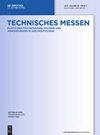Analysis of thrombosis risk of commissural misaligned transcatheter aortic valve prostheses using particle image velocimetry
IF 0.7
4区 工程技术
Q4 INSTRUMENTS & INSTRUMENTATION
引用次数: 2
Abstract
Abstract Due to excellent clinical results, transcatheter aortic valve replacement (TAVR) has evolved to a treatment option for patients with low surgical risk, resulting in an increasing demand for durable heart valve prostheses. Durability of TAVR could be limited by leaflet thrombosis. Thrombus formation in the aortic root is mainly affected by the hemodynamic situation, which is dependent on the positioning of the implant. We investigated the flow field in the aortic root after TAVR implantation by means of particle image velocimetry. To quantify the influence of the implant-position with respect to an alignment or misalignment of the leaflet commissures on the thrombogenic potential, we used a transport equation for residence time (RT) to consider washout behavior. Furthermore, we introduced a shear effect criterion (SIE) to address platelet activation as a measure for a potential thrombus formation. Misaligned implantation of a TAVR resulted in a reversed direction of rotation of the occurring recirculation area. This led to fluid flow with comparable areas of increased relative blood RT (RTaligned: 97.6%, RTmisaligned: 88.0%) and a smaller area of low shear load for the misaligned TAVR (SIEaligned: 57.7%, SIEmisaligned: 3.70%) into the sinus region, indicating a higher potential for thrombus formation.颗粒图像测速法分析关节错位经导管主动脉瓣假体血栓形成风险
由于出色的临床效果,经导管主动脉瓣置换术(TAVR)已发展成为低手术风险患者的治疗选择,导致对耐用心脏瓣膜假体的需求不断增加。TAVR的持久性可能受到小叶血栓形成的限制。主动脉根部血栓的形成主要受血流动力学状况的影响,而血流动力学状况又依赖于植入物的位置。我们用粒子图像测速法研究了TAVR植入术后主动脉根部的流场。为了量化植入位置对小叶相交对齐或不对齐对血栓形成潜力的影响,我们使用了停留时间(RT)的传递方程来考虑冲洗行为。此外,我们引入了剪切效应标准(SIE)来解决血小板活化作为潜在血栓形成的措施。错位植入TAVR导致发生再循环区的旋转方向相反。这导致相对血液RT增加的区域(rtalaligned: 97.6%, RTmisaligned: 88.0%)和错位TAVR的低剪切负荷面积更小(SIEaligned: 57.7%, siemaligned: 3.70%)的流体流入窦区,表明血栓形成的可能性更高。
本文章由计算机程序翻译,如有差异,请以英文原文为准。
求助全文
约1分钟内获得全文
求助全文
来源期刊

Tm-Technisches Messen
工程技术-仪器仪表
CiteScore
1.70
自引率
20.00%
发文量
105
审稿时长
6-12 weeks
期刊介绍:
The journal promotes dialogue between the developers of application-oriented sensors, measurement systems, and measurement methods and the manufacturers and measurement technologists who use them.
Topics
The manufacture and characteristics of new sensors for measurement technology in the industrial sector
New measurement methods
Hardware and software based processing and analysis of measurement signals to obtain measurement values
The outcomes of employing new measurement systems and methods.
 求助内容:
求助内容: 应助结果提醒方式:
应助结果提醒方式:


